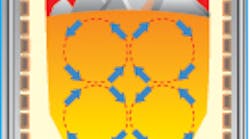Electromagnetic forces create constant motion that force inclusions together and promote better alloy mixing.
Induction furnaces have been popular for a long time in both ferrous and nonferrous foundries due to their clean operation and greatly reduced air pollution and noise level. They produce homogeneous alloy and metal temperatures using natural metal stirring which reduces refractory costs when compared to furnace linings with improperly sized stirring.
The electromagnetic forces imparted on the molten metal by induction melting produce a constant motion which forces inclusions to join together for easier slag removal and much cleaner metal. This motion also promotes a more complete mixing of alloying materials which is essential for the production of aluminum hardener alloys and other applications requiring a high degree of alloy consistency.
While natural flow patterns and stirring of metal in an induction furnace create a cleaner metal, induction melting installations should be carefully selected for proper stirring characteristics to ensure the best performance to suit the application. The application and charge material will define furnace size and type, optimal frequency and power. A formula can be used to calculate the level of stirring in a given system using factors that include power, frequency, furnace size and the alloy being melted.
Iron foundries normally want a medium amount of bath stirring to properly mix in additives and provide a homogeneous alloy. One foundry melting ductile base iron achieves its desired level of stirring with a 9,000 kW induction melter powering a 12.5 metric ton furnace. This system operates at 210 Hz with a medium stirring index of 42.3. A larger foundry melting gray iron runs its 16,500 kW, 20 metric ton induction melting system at 180 Hz to achieve a medium stirring index of 47.9.
Some aluminum melting demands a higher level of stirring. One aluminum alloy producer achieves its required stirring with a 300 kW induction power supply running a 0.8 metric ton furnace. Operating at 60 Hz, it produced a very heavy stirring index of 117.27. An aluminum alloy producer melting UBCs runs its 1,500 kW, 7 metric ton aluminum melting system at 60 Hz to achieve a heavy stirring index of 75.7.
Steel foundries typically pour their alloys at high temperatures and want a low level of stirring to maximize lining life and minimize gas pickup. A steel abrasive plant operates a 1,500 kW induction power supply and 2.2 metric ton furnace at 590 Hz to achieve a light stirring index of 22.6. A steel investment casting plant melting various steel alloys runs its 175 kW, 75 kg induction melting system at 2,800 Hz to achieve a light stirring index of 25.7.
Induction melting allows you to melt large batches of metal and still produce the proper stirring needed for a homogeneous bath by selecting a frequency that results in the desired stirring level given the power and furnace size chosen.
With their continually increasing size, high power density induction melting systems today present another option to the original electric batch melter — the electric arc furnace. Induction furnaces offer a number of advantages over arc furnaces in most foundry operations, including better metal homogeneity. The inductive stirring that takes place during full-power induction melting is a valuable benefit in most foundry applications, aiding the formation of homogeneous alloys and promoting uniform bath temperature.
Since induction technology heats the metal/materials directly, there are no hot spots anywhere in the furnace. The even, homogeneous temperature of the metal and refractories reduces hydrogen pick-up and oxidation of the metal compared with alternative methods of melting. This leads to higher-quality metal with lower levels of inclusions and porosity. Reduced porosity and reduced inclusions result in less time and expense involved in removing waste slag or dross from the furnace, ultimately lowering labor cost.
In vacuum refining applications, however, further stirring is needed at the end of the melt. But using full induction power for this stirring is not practical because the bath would superheat. There are two ways to provide the end-of-the-melt stirring needed by some applications. The first is Multi-phase Stirring. By combining a multi-output power supply with a multi-section coil, strong inductive stirring can be provided at low power levels. This offers ample stirring action without superheating the bath. The second is FM Stirring. With this arrangement, low power is injected, at very low frequency, producing resonant wave action in the metal.
Induction stirring is a natural by-product and benefit of melting with induction technology. It’s a cost-effective way to increase your productivity and metal quality without requiring any additional downstream operations.
Robert Keshecki is a district manager with Inductotherm Corp. Visit www.inductotherm.com












